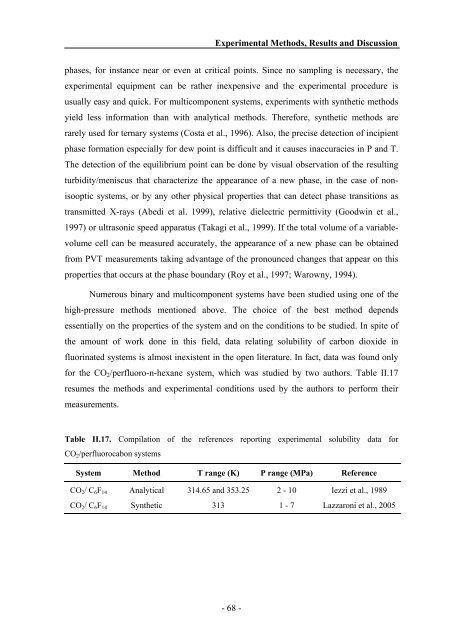n - PATh :.: Process and Product Applied Thermodynamics research ...
n - PATh :.: Process and Product Applied Thermodynamics research ...
n - PATh :.: Process and Product Applied Thermodynamics research ...
You also want an ePaper? Increase the reach of your titles
YUMPU automatically turns print PDFs into web optimized ePapers that Google loves.
Experimental Methods, Results <strong>and</strong> Discussion<br />
phases, for instance near or even at critical points. Since no sampling is necessary, the<br />
experimental equipment can be rather inexpensive <strong>and</strong> the experimental procedure is<br />
usually easy <strong>and</strong> quick. For multicomponent systems, experiments with synthetic methods<br />
yield less information than with analytical methods. Therefore, synthetic methods are<br />
rarely used for ternary systems (Costa et al., 1996). Also, the precise detection of incipient<br />
phase formation especially for dew point is difficult <strong>and</strong> it causes inaccuracies in P <strong>and</strong> T.<br />
The detection of the equilibrium point can be done by visual observation of the resulting<br />
turbidity/meniscus that characterize the appearance of a new phase, in the case of nonisooptic<br />
systems, or by any other physical properties that can detect phase transitions as<br />
transmitted X-rays (Abedi et al. 1999), relative dielectric permittivity (Goodwin et al.,<br />
1997) or ultrasonic speed apparatus (Takagi et al., 1999). If the total volume of a variablevolume<br />
cell can be measured accurately, the appearance of a new phase can be obtained<br />
from PVT measurements taking advantage of the pronounced changes that appear on this<br />
properties that occurs at the phase boundary (Roy et al., 1997; Warowny, 1994).<br />
Numerous binary <strong>and</strong> multicomponent systems have been studied using one of the<br />
high-pressure methods mentioned above. The choice of the best method depends<br />
essentially on the properties of the system <strong>and</strong> on the conditions to be studied. In spite of<br />
the amount of work done in this field, data relating solubility of carbon dioxide in<br />
fluorinated systems is almost inexistent in the open literature. In fact, data was found only<br />
for the CO2/perfluoro-n-hexane system, which was studied by two authors. Table II.17<br />
resumes the methods <strong>and</strong> experimental conditions used by the authors to perform their<br />
measurements.<br />
Table II.17. Compilation of the references reporting experimental solubility data for<br />
CO2/perfluorocabon systems<br />
System Method T range (K) P range (MPa) Reference<br />
CO2/ C6F14 Analytical 314.65 <strong>and</strong> 353.25 2 - 10 Iezzi et al., 1989<br />
CO2/ C6F14 Synthetic 313 1 - 7 Lazzaroni et al., 2005<br />
- 68 -



